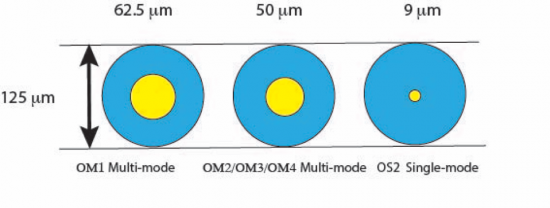Written by Priya Maratukulam, Product Manager, Transceiver Modules Group, Cisco
In our previous post we described the phenomenon of total internal reflection and how it enables light to travel long distances down optical fibers. In this post we will discuss different types of optical fiber. The two main types are single-mode and multi-mode fiber.

As described in our previous post, optical fiber has the structure of a core surrounded by cladding. The core and cladding are both glass with different indices of refraction. The core of single-mode fiber is much smaller than that of multi-mode but the cladding diameters of both are the same.
Fiber optic transmission occurs because optical fiber acts as a waveguide. The light signals that are transmitted down the fiber create modes, or stable patterns, in which a wave can travel down the waveguide. The number of possible modes that can be transmitted by the waveguide, for a given wavelength of light, increases as the core diameter of the fiber increases.
Single-mode fiber has a core that is sized so that it only propagates one mode for a given wavelength of light. The maximum core diameter for single-mode transmission depends on the wavelength of the light the fiber is transmitting. For a given core diameter of fiber there is a cutoff wavelength below which the fiber will carry more than one mode, and above which the fiber will be single-mode. Typical single-mode fiber has a core diameter of 9 microns and operates at 1310 and 1550nm wavelengths of light.

When the wavelength of the light propagating down the fiber is shorter than the cutoff wavelength for a given core diameter of fiber, multiple modes can be transmitted. Multi-mode fiber has a larger core size than single-mode fiber. Typical cores sizes are 50 microns and 62.5 microns and a typical operating wavelength for multi-mode fiber is 850nm.

Older multi-mode fiber used low-cost light emitting diodes (LEDs) to transmit their light signals. One of the earliest multi-mode fibers, Optical Multi-mode 1 (OM1), has a larger core diameter of 62.5 microns. Optical Multi-mode 2 (OM2) has a smaller core size of 50 microns and a higher bandwidth. LED light sources cannot be modulated quickly, so in order to reach higher data rates, laser sources were required. Optical Multi-mode 3 (OM3) was developed to work with vertical cavity surface emitting lasers (VCSELs) that operate at 750- 850nm. Optical Multi-mode 4 (OM4) is also laser optimized but has a longer reach than OM3. Single-mode fibers require longer wavelength, 1300nm or 1550nm laser sources. These lasers are either Fabry-Perot (FP) or Distributed Feedback (DFB) type lasers.

Contrary to what you might think, the larger core size of multi-mode fiber does not carry as much data as single-mode fiber. We tend to think of larger pipes carrying more material than smaller pipes, but in the case of optical fiber the opposite is true. Multi-mode fiber has lower bandwidth than single-mode fiber. Effects such as modal dispersion and modal noise limit the amount of data the multi-mode fiber can carry.
Modal dispersion spreads an initial near-instantaneous edge of a pulse out over time when the light signal gets to its destination. This limits how quickly the light can be turned on and off and thus limits the bandwidth of the fiber. These effects also limit how far the light signal can travel down the fiber before neighboring pulses bleed into each other.
Cisco has transceivers that use both multi-mode and single-mode fiber. Some common transceivers that employ multi-mode fiber are SFP-10G-SR or SFP-GE-S. Some common transceivers that employ single-mode fiber are SFP-10G-LR and GLC-LH-SMD. In general, the transceivers whose reach is 1 km or less employ multi-mode fiber and transceivers whose reach is greater than 1 km employ single-mode fiber. This is due to the modal dispersion in multi-mode fiber described above. At higher data rates, the reach of multi-mode transceivers is less than 1km.
In our next post we will go into more detail about modal dispersion in multi-mode fiber.

Very informative!
Thank you for an excellent post! Would you be able provide an example, or better yet, an analogy that explains modal dispersion?
One way to think about modal dispersion is using the ray model of light, since each mode has a characteristic velocity in step index multi-mode fiber, it’s like different modes are distinct rays of light entering the fiber at different angles. Since each ray is traveling a different path this causes the instantaneous pulse to spread out over time. A good analogy is that of runners in a marathon race. At the start of the race the runners are tightly packed together crossing the start line. By the end of the race runners are widely dispersed and the gap between the winner and the last runner can be an hour or more. Here is a wikipedia article on modal dispersion. https://en.wikipedia.org/wiki/Modal_dispersion
Excellent analogy!!
I have been promoting transceivers for quite some time. But i am still not sure, which kind of Cisco transceiver is going to be good for my system. Is Cisco Glc-sx-mm good or you can suggest some other one.
<a href="https://www.gbic-shop.de/de/produkte/transceiver/sfp/kompatibel-6/1000base-sx/cisco-glc-sx-mm-detail.html"> Monika@cisco-glc-sx-mm</a>
Hi Monika, it depends on your situation. Please ask your Cisco account manager to reach out to me, and we can start the dialogue.
Pat,
This is a great post that includes not just the multi-mode and single-mode fiber concepts, but also includes the fiber type specifics such as OM2 and OS2. All great information to have available, especially when attending Cisco Live and speaking with various vendors concerning fiber, TAPs, and transceivers.
Thanks!
Hi Vincent, thanks for the kind comment! Credit goes to my colleague Priya Maratukulam, who wrote this post.
Thanks Priya Maratukulam!
I've bookmarked this post for future reference. Again, great information!!
Pat Chou — thanks for the follow-up and all the responses to the questions regarding this post!